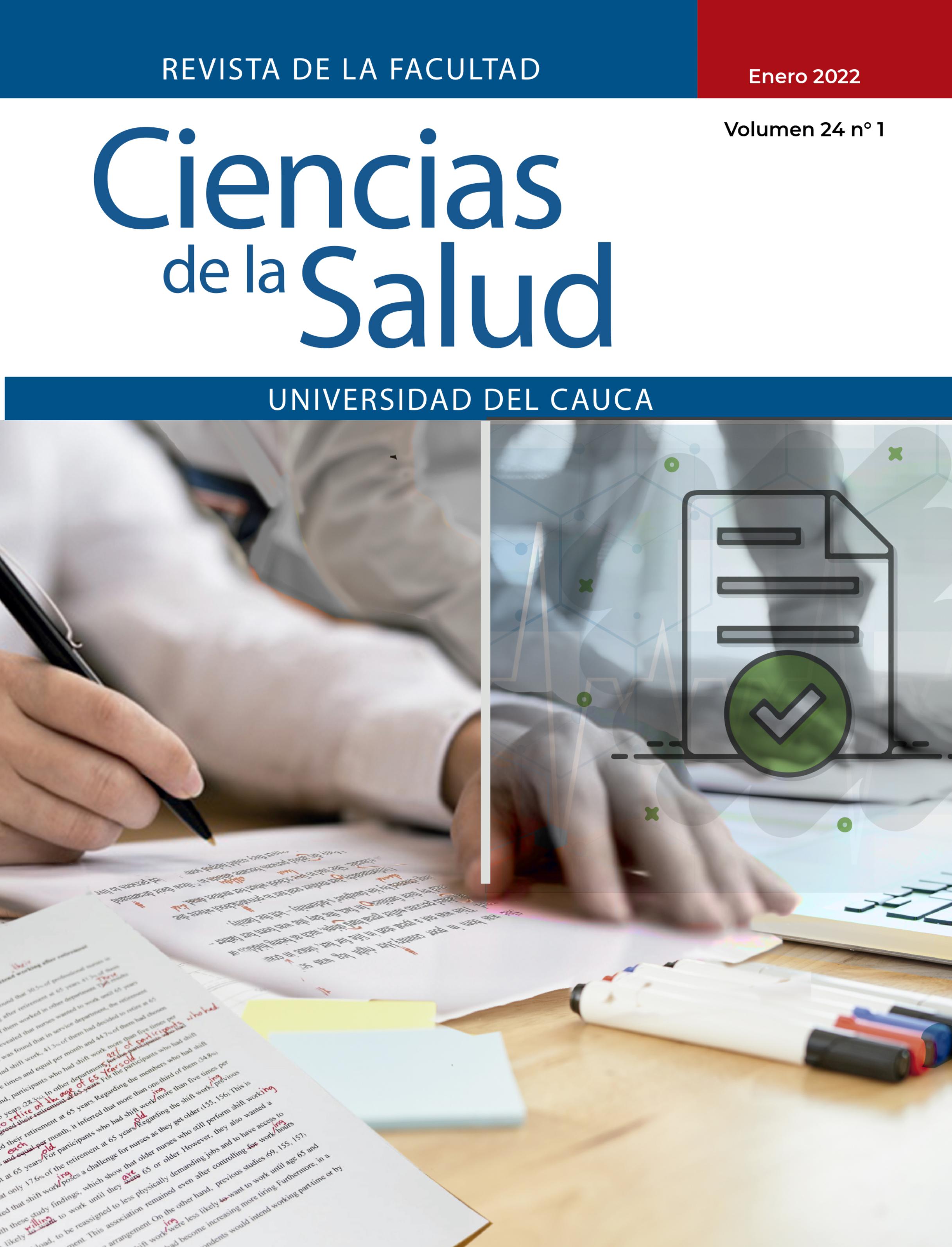Susceptibility in vitro to cyprofloxacin in biofilm of Pseudomonas aeruginosa and planktonic stocks. Cross-sectional study.
Abstract
Introduction: Bacterial biofilms are a serious problema in health care, mainly in infections associated with health care. They have a high capacity to adapt to the environment and nutritional requirements. In addition, due to its composition and low concentrations of antibiotics, it generates tolerance that prevents its growth from being inhibited.
Objective: To determine the in vitro susceptibility to ciprofloxacin in Pseudomonas aeruginosa biofilms. Methods: The susceptibility of the biofilm of 7 strains of Pseudomonas aeruginosa belonging to the strain collection of the University of Boyacá obtained from clinical samples of urinary origin will be prolonged using the microtiter plate method.
Results: An increase in tolerance was demonstrated in 6 strains of the 7 analyzed, reaching a decrease in growth up to a concentration of 4 μg/ml compared to its planktonic form, which modified inhibit growth up to a concentration of 14 μg/ml. As for the single resistant strain in its planktonic form, no significant changes were observed.
Conclusions: One of the analyzed biofilms presented a different behavior to ciprofloxacin, probably due to its genotype, microenvironment and/or its growth form.
Downloads
Disciplines:
Infectious diseasesReferences
V Vickery K. Special Issue: Microbial Biofilms in Healthcare: Formation, Prevention and Treatment. Materials. 2019;12(12):2001. https://doi.org/10.3390/ma12122001
Parkins MD, Somayaji R, Waters VJ. Epidemiology, Biology, and Impact of Clonal Pseudomonas aeruginosa Infections in Cystic Fibrosis. Clin Microbiol Rev. 2018;31(4). https://doi.org/10.1128/CMR.00019-18
Abadia E, Rodríguez O, De La Cruz A. Efectividad de la formación de biofilms por cepas de pseudomona y su capacidad de disminución de cloro y antagónica de bacterias coliformes. Rev Iniciación Científica. 2019; 5:74-78. https://doi.org/10.33412/rev-ric.v5.0.2389
Azam MW, Khan AU. Updates on the pathogenicity status of Pseudomonas aeruginosa. Drug Discov Today. 2019;24(1):350-9. https://doi.org/10.1016/j.drudis.2018.07.003
Hurtado Quispe LM, Casablanca Alvarado J. Asociación entre la formación de biofilm y la producción de betalactamasas de espectro extendido en escherichia coli aislados de urocultivo en el hospital nacional hipolito unanue de enero-junio 2018. Univ Priv Norbert Wiene. 2019. Disponible en: http://repositorio.uwiener.edu.pe/handle/123456789/2918
Paz-Zarza VM, Mangwani-Mordani S, Martínez-Maldonado A, Álvarez-Hernández D, Solano-Gálvez SG, Vázquez-López R, et al. Pseudomonas aeruginosa: patogenicidad y resistencia antimicrobiana en la infección urinaria. Rev Chil infectología. 2019;36(2):180–9. http://dx.doi.org/10.4067/S0716-10182019000200180
Alonso B, Fernández-Barat L, Domenico EG Di, Marín M, Cercenado E, Merino I, et al. Characterization of the virulence of Pseudomonas aeruginosa strains causing ventilator-associated pneumonia. BMC Infectious Diseases. 2020;20(1):1-8. https://doi.org/10.1186/s12879-020-05534-1
Agbo Ejiofor C, Ejinaka Obiora R, Obeta Uchejeso, Lote-Nwaru Ifeoma E, Ibanga Imoh E, Dajok Godfrey. Antimicrobial Susceptibility Pattern of Biofilm forming Pseudomonas aeruginosa Isolated from Noncritical Surfaces in a Tertiary Healthcare Facility in South Eastern Nigeria. Am J Public Heal Res. 2020;8(3):87-92. http://dx.doi.org/10.12691/ajphr-8-3-2
Bahador N, Shoja S, Faridi F, Dozandeh-Mobarrez B, Qeshmi FI, Javadpour S, et al. Molecular detection of virulence factors and biofilm formation in Pseudomonas aeruginosa obtained from different clinical specimens in Bandar Abbas. Iran J Microbiol. 2019;11(1):25-30.
Erin KC, Boo Shan Tseng. Pushing beyond the Envelope: the Potential Roles of OprF in Pseudomonas aeruginosa Biofilm Formation and Pathogenicity. Journal of bacteriology. 2019; 201(18): e00050-19. https://doi.org/10.1128/JB.00050-19
Vestby LK, Grønseth T, Simm R, Nesse LL. Bacterial Biofilm and its Role in the Pathogenesis of Disease. Antibiotics. 2020; 9(2): 59. https://doi.org/10.3390%2Fantibiotics9020059
Asati S, Chaudhary U. Prevalence of biofilm producing aerobic bacterial isolates in burn wound infections at a tertiary care hospital in northern India. Ann Burns Fire Disasters. 2017;30(1):39-42.
Del Pozo JL. Expert Review of Anti-Infective Therapy. Biofilm-related disease. Vol. 16. Taylor and Francis Ltd; 2018. p. 51-65.
Olivares E, Badel-Berchoux S, Provot C, Prévost G, Bernardi T, Jehl F. Clinical Impact of Antibiotics for the Treatment of Pseudomonas aeruginosa Biofilm Infections. Front Microbiol. 2020;10:2894. https://doi.org/10.3389%2Ffmicb.2019.02894
Ciofu O, Tolker-Nielsen T. Tolerance and Resistance of Pseudomonas aeruginosa Biofilms to Antimicrobial Agents—How P. aeruginosa Can Escape Antibiotics. Front Microbiol. 2019;10(5):913. https://doi.org/10.3389/fmicb.2019.00913
Stepanović S, Ćirković I, Ranin L, Švabić-Vlahović M. Biofilm formation by Salmonella spp. and Listeria monocytogenes on plastic surface. Lett Appl Microbiol. 2004;38(5):428-32. https://doi.org/10.1111/j.1472-765x.2004.01513.x
Bi Y, Xia G, Shi C, Wan J, Liu L, Chen Y, et al. Therapeutic strategies against bacterial biofilms. Fundam Res. 2021;1(2):193-212. https://doi.org/10.1016/j.fmre.2021.02.003
Ibarra-Trujillo C, Villar-Vidal M, Gaitán-Cepeda LA, Pozos-Guillen A, Mendoza-de Elias R, Sánchez-Vargas LO. Ensayo de formación y cuantificación de biopelículas mixtas de Candida albicans y Staphylococcus aureus. Rev Iberoam Micol. 2012;29(4):214-22. https://doi.org/10.1016/j.riam.2012.02.003.
Silvestre Ortega-Peña, Edgar Hernández-Zamora. Biopelículas microbianas y su impacto en áreas médicas: fisiopatología, diagnóstico y tratamiento. Hosp Infant Mex. 2018;75(2):79-88. https://doi.org/10.24875/bmhim.m18000012
Marques CNH, Nelson SM. Pharmacodynamics of ciprofloxacin against Pseudomonas aeruginosa planktonic and biofilm-derived cells. Lett Appl Microbiol. 2019;68(4):350-9. https://doi.org/10.1111/lam.13126
Azevedo FCR, Vaz ICD, Barbosa FAR, Magalhães SMS. Toxicological effects of ciprofloxacin and chlorhexidine on growth and chlorophyll a synthesis of freshwater cyanobacteria. Brazilian J Pharm Sci. 2019; 55:17661. https://doi.org/10.1590/s2175-97902019000217661
Gupta P, Chhibber S, Harjai K. Subinhibitory concentration of ciprofloxacin targets quorum sensing system of pseudomonas aeruginosa causing inhibition of biofilm formation & reduction of virulence. Indian J Med Res. 2016;143(5):643-51. https://doi.org/10.4103%2F0971-5916.187114
Sufya N, Allison DG, Gilbert P. Clonal variation in maximum specific growth rate and susceptibility towards antimicrobials. J Appl Microbiol. 2003;95(6):1261-7. https://doi.org/10.1046/j.1365-2672.2003.02079.x
Allison KR, Brynildsen MP, Collins JJ. Metaboliteenabled eradication of bacterial persisters by aminoglycosides. Nature. 2011;473(7346):216-20. https://doi.org/10.1038/nature10069
Bjarnsholt T, Jensen PØ, Fiandaca MJ, Pedersen J, Hansen CR, Andersen CB, et al. Pseudomonas aeruginosa biofilms in the respiratory tract of cystic fibrosis patients. Pediatr Pulmonol. 2009;44(6):547-58. https://doi.org/10.1002/ppul.21011
Drlica K, Hiasa H, Kerns R, Malik M, Mustaev A, Zhao X. Quinolones: Action and Resistance Updated. Curr Top Med Chem. 2009;9(11):981-98. https://doi.org/10.2174%2F156802609789630947
Flemming HC, Wingender J. The biofilm matrix. Nat Rev Microbiol. 2010;8(9):623-33. https://doi.org/10.1038/nrmicro2415
Bolivar-Vargas AF, Torres-Caycedo MI, Sánchez-Neira Y. Biofilms de Pseudomonas aeruginosa como mecanismos de resistencia y tolerancia a antibióticos. Revisión narrativa. Rev. Fac. Cienc. Salud Univ. Cauca 22 de noviembre de 2021;23(2):47. https://doi.org/10.47373/rfcs.2021.v23.1780
Copyright (c) 2022 Universidad del Cauca

This work is licensed under a Creative Commons Attribution-NonCommercial-NoDerivatives 4.0 International License.












.png)



